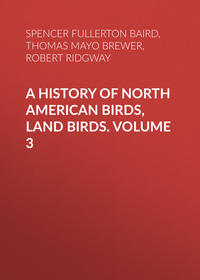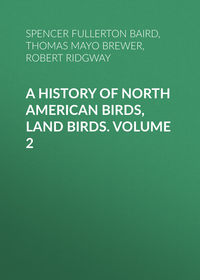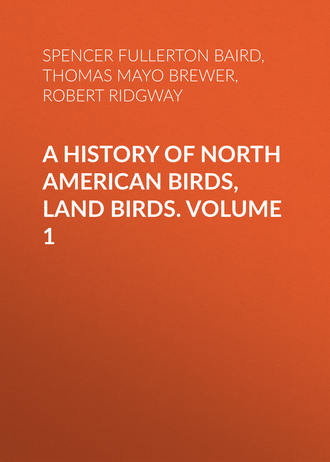 полная версия
полная версияA History of North American Birds, Land Birds. Volume 1
This species in general form resembles the A. ludovicianus, the fifth primary in both being abruptly and considerably shorter than the outer four; the bill and legs quite similar. The average size appears much the same. The upper parts are, however (especially the head and back), more distinctly streaked with dusky; the edge and inside of wing greenish-yellow, not white, and the upper plumage and outer edges of the quills decidedly olive-green. The shafts of the middle tail-feathers above are whitish, not dark brown; the under parts greenish-white, conspicuously streaked with dark brown. The bill is dusky, the base and edges paler; the legs dusky flesh-color, not dark brown.
The occurrence of this species in Greenland was noticed in the Review; and since the publication of that work a specimen has been obtained at St. Michael’s, in Alaska, by Mr. W. H. Dall, and is now in the Smithsonian collection. The specimen in question appears to be the true pratensis.
Habits. This European species claims a place in the North American fauna on the ground of a single specimen having been found in Greenland, in 1845, and one at St. Michael’s, Norton Sound. In the Old World it is the counterpart of our ludovicianus, which, in all respects, it closely resembles. It is the most common and the best known of European Titlarks. In Great Britain, where it is found throughout the year, it appears to prefer the uncultivated districts, inhabiting commons and waste lands, and in the more northern parts frequenting the moors. It is also found in meadows and marsh lands, in winter seeking more sheltered places. It is rarely seen to alight on a branch or to sit on a rail. Its song is soft and musical, and is usually uttered when on the wing or when vibrating over its nest. It seeks its food altogether on the ground, running nimbly in pursuit of insects, slugs, and worms. According to Yarrell its nest is built on the ground, generally among the grass. It is composed externally of dried sedges, lined with finer materials and some hair. The eggs are six in number, of a reddish-brown color, mottled over with darker shades of the same, and measure .80 by .60 of an inch.
According to the observations of English naturalists, this bird resorts to various ingenious devices to conceal its nest, or to draw aside attention from it, such as feigning lameness when it is approached, and concealing it by artificial covering when it has been once discovered.
The Meadow Pipit is common during the summer months in Denmark, Sweden, and Norway, visiting also the Faroe Islands and Iceland. It inhabits the whole continent of Europe as far south as Spain, Italy, and Sicily. It has also been found in Northern Africa, and, according to Gould, in Western Asia. Temminck also states it to be among the birds of Japan.
According to Degland these larks, after the breeding-season, unite in small flocks, probably families, and frequent low and damp localities. In summer they are more often found on high and dry mountain plains. Their flesh is said to be delicious.
Genus NEOCORYS, SclaterNeocorys, Sclater, Pr. Zoöl. Soc. Lond. 1857, 5. (Type, Alauda spraguei, Aud.)
Char. Bill half as long as the head; the culmen concave at the base, slightly decurved at the tip. Rictus without bristles. Legs stout; tarsi distinctly scutellate, longer than the middle toe. Hind toe very long, equal to the tarsus, much longer than the middle toe; its claw but slightly curved, and about half the total length. Inner lateral toe rather longer than outer. Wings much longer than tail; first quill longest. Tertials considerably longer than secondaries. Tail rather short, emarginate.
But one species of this genus is known, it being peculiar to the Western plains.
Neocorys spraguei, SclatMISSOURI SKYLARK; SPRAGUE’S PIPITAlauda spraguei, Aud. Birds Am. VII, 1843, 335, pl. cccclxxxvi. Agrodoma spraguei, Baird, Stansbury’s Rep. 1852, 329. Neocorys spraguei, Sclater, P. Z. S. 1857, 5.—Baird, Birds N. Am. 1858, 234.—Blakiston, Ibis, 1862, 4 (Saskatchewan).—Cooper, Orn. Cal. 1, 1870, 80. Anthus (Neocorys) spraguei, Baird, Rev. 155.
Sp. Char. Above wood-brown, all the feathers edged with paler, especially on the neck, where there is a brownish-yellow tinge. The under parts are dull white, with a collar of sharply defined narrow brown streaks across the forepart and along the sides of the breast. Lores and a superciliary line whitish. Tail-feathers, except the middle ones, dark brown; the outer one white, the second white, with the inner margin brown. The outer primary is edged with white, and there are two dull whitish bands across the wings. Bill and feet yellow, the former brown above. Length (female), 5.75; wing, 3.35; tail, 2.50.
Hab. Plains of Yellowstone and Upper Missouri to Saskatchewan; Nebraska.

Neocorys spraguei.
16766
This little-known species has the general appearance of a Titlark, but is readily distinguished from Anthus ludovicianus by the purer white of its under parts, the much darker centres and much paler margins to the feathers above, the entirely white external tail-feather, and the yellow legs and bill, as well as by its generic peculiarities. In its song and general habits it approaches nearer the European Skylark than any bird belonging to our fauna.
Habits. This interesting species was first described by Audubon, in the supplementary portion of his Birds of America. It was obtained by the party which accompanied him to the Upper Missouri in 1843. It was first met with on the 19th of June near Fort Union, in Dacotah Territory. It has since been found on the fork of the Saskatchewan, but little additional information respecting its habits has been obtained since its first discovery.
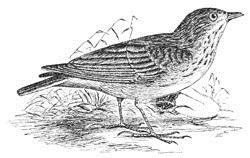
Neocorys spraguei.
It seems to more nearly approach, in its habits, the European Skylark than any other of our North American birds. Mr. Edward Harris was completely misled, at first, by the sound of their song, so that on several occasions he sought for them on the ground. Their voices appeared to come to him from the earth’s surface. After having travelled in quest of them, to no purpose, to many distant parts of the prairies, he at last discovered that these sounds proceeded from several of these birds soaring at so great an elevation as to make them difficult to discover by the eye, even in the transparent atmosphere of that country.
They are described as running gracefully on the ground, at times squatting to observe the movements of the intruders, and again elevating their bodies as if to meet their approach. Rising from the ground, they fly in an undulating manner, so that it is extremely difficult to shoot them on the wing. They continue thus to fly in increasing circles until about a hundred yards high, when they begin to sing. After a while, suddenly closing their wings, they drop to the ground. They could be easily approached in a light wagon, and in this manner several specimens were obtained.
Captain Blakiston (Ibis, V. 61) found this Skylark common on the prairies of the Saskatchewan during the breeding-season. He first met with it on the 6th of May, near Fort Carlton. When disturbed from the grass, its usual haunt, it utters a single chirp, and immediately mounts in the air by a circuitous course, with a very undulating flight, to a great height, where with outstretched wings it soars in a peculiar manner, and utters a very striking song. This is described as consisting of a quick succession of notes, in a descending scale, each note being lower than the preceding. The bird then descends to the ground with great rapidity, almost like a stone, and somewhat in the manner of a hawk swooping on its prey. It was difficult of approach, and not easily killed. He also observed these birds in Northern Minnesota, May 4, 1859.
A nest of this bird was built on the ground and placed in a hollow. It was made of fine grasses interwoven into a circular form, but without any lining. The eggs were four or five in number, an oblong oval in shape, much pointed at one end, and measuring .87 of an inch in length by .63 in breadth. Their ground-color was a dull white, so minutely dotted with a grayish-purple as to give the whole egg a homogeneous appearance, as of that uniform color.
The young larks, soon after being hatched, followed their parents on the ground, and were fed with seeds of the smaller plants and with insects. They had already begun to associate in small flocks of from eight to a dozen before the party left, and on the 16th of August had commenced their southern migrations.
Family SYLVICOLIDÆ.—The Warblers
The Sylvicolidæ are essentially characterized among the Oscines with nine primaries, by their small size, the usually slender and conical insectivorous bill, shorter than the head, without angle in the gape near the base; the toes deeply cleft so as to leave the inner one free almost to its very base (except in Mniotiltæ), etc. The shallow notch at the end of the tongue, instead of a deeply fissured tip, distinguishes the family from the Cærebidæ, to some of which there is otherwise so great a resemblance. The absence of abrupt hook and notch in both mandibles separates it from such of the Vireonidæ as have nine primaries.
The American Motacillidæ are distinguished from the Sylvicolidæ by the emargination of the outer and the great elongation of the inner secondaries, as well as by other features referred to under that family. Anthus, in particular, differs in the lengthened and slightly curved hind claw. There is little difficulty in distinguishing the Sylvicolidæ, however, from any families excepting the slender-billed forms of the Tanagridæ, as Chlorospingus, Nemosia, Chlorochrysa, etc., and the conirostral Cœrebidæ. In fact, some ornithologists are inclined to include all three of the families thus mentioned in one, from the difficulty of marking their boundaries respectively.
In fact, we are of the opinion that no violence would be done by adopting this view, and would even include with the above-mentioned families the Fringillidæ also. The order of their relation to one another would be thus: Fringillidæ, Tanagridæ, Sylvicolidæ, Cœrebidæ; there being scarcely any break in the transition between the two extremes, unless there are many genera referred to the wrong family, as seems very likely to be the case with many included in the Tanagridæ. The fringilline forms of the latter family are such genera as Buarremon and Arremon, they being so closely related to some fringilline genera by so many features—as rounded concave wing, lax plumage, and spizine coloration—as to be scarcely separable. Either these two families are connected so perfectly by intermediate forms as to be inseparable, or the term Tanagridæ covers too great a diversity of forms. With the same regularity that we proceed from the Fringillidæ to the typical forms of the Tanagridæ (Pyranga, Tanagra, Calliste, etc.), we pass down the scale from these to the Sylvicolidæ; while between many genera of the latter family, and others referred to the Cærebidæ, no difference in external anatomy can be discovered, much less expressed in a description.
In the following synopsis we attempt to define the higher groups of the Sylvicolidæ, although in the large number of species and their close relationships it is very difficult to express clearly their distinctive features.
SubfamiliesA. Bill conical, its bristles very weak, or wanting.
a. Bill sub-conical, the culmen and commissure nearly straight.
Sylvicolinæ. Feet weak, not reaching near the end of the tail. Wing pointed, considerably longer than the nearly even or slightly emarginated tail. Feet dark-colored (except in Helmitherus, Helinaia, and Parula). Arboreal.
Geothlypinæ. Feet strong, reaching nearly to end of the tail. Wing rounded. Feet pinkish-white. Terrestrial.
b. Bill high and compressed, the culmen and commissure much curved.
Icterianæ. Bill without notch or rictal bristles; wing much rounded, shorter than the tail.
B. Bill depressed, its bristles strong.
Setophaginæ. Bill, tyrannine, considerably broader than high, the tip more or less hooked, and with a distinct notch. Rictal bristles reaching half-way, or more, to the tip.
Sections and GeneraSYLVICOLINÆ1. Middle toe, with claw, longer than tarsus.
Mniotilteæ. Bill much compressed for terminal half, the lateral outline decidedly concave; culmen and gonys decidedly convex; commissure moderately concave. Rictal bristles very inconspicuous; notch just perceptible … Mniotilta.
2. Middle toe, with claw, not longer than tarsus.
Vermivoreæ. Bill without a distinct notch, or lacking it entirely; rictal bristles wanting, or very minute; culmen and gonys nearly straight; bill only very moderately compressed.
a. Middle toe and claw about equal to tarsus.
Bill not acute; culmen and gonys decidedly convex; notch just perceptible; bristles apparent … Protonotaria.
Bill moderately acute, robust; no notch; culmen straight, its base elevated and slightly arched; bristles not apparent … Helinaia.
Bill moderately acute; robust; no notch; culmen convex, its base not elevated; bristles apparent … Helmitherus.
b. Middle toe and claw considerably shorter than tarsus.
Bill very acute, its outlines nearly straight; notch not perceptible; bristles not apparent … Helminthophaga.
Bill very acute, its outlines nearly straight; notch just perceptible; bristles strong … Parula.
Sylvicoleæ. Bill distinctly notched; rictal bristles strong; outlines generally slightly curved.
Bill acute, gonys slightly concave … Perissoglossa.
Bill not acute, gonys convex … Dendroica.
GEOTHLYPINÆ3. Wings pointed, longer than the nearly even tail.
Seiureæ.
Above olive-brown; beneath white with dark streaks … Seiurus.
Above olive-green; beneath yellow without streaks … Oporornis.
4. Wings rounded, shorter than the graduated tail.
Geothlypeæ.
Above olive-green; beneath yellow, without streaks … Geothlypis.
ICTERIANÆ5. Bill very deep and compressed; tail graduated; outer toe deeply cleft.
Icterieæ.
Olive-green above; bright yellow anteriorly beneath. Upper mandible deeper than the lower … Icteria.
Plumbeous-blue above; red, black, and white beneath. Upper mandible not so deep as the lower … Granatellus.
6. Bill slender, sub-conical, but curved; tail nearly even; outer toe adherent for basal half.
Teretristeæ.
Above olive-gray; beneath whitish posteriorly, and yellow anteriorly … Teretristis.
SETOPHAGINÆ7. Bill tyrannine. Tail broad, equal to or longer than the wing, and much rounded.
Setophageæ. Colors mainly black, red, and white.
Tail not longer than the wing. Above black, wing variegated … Setophaga.
Tail longer than the wing. Above plumbeous, wing unvariegated … Myioborus.
8. Bill sylvicoline. Tail narrow, almost even; shorter than the wing.
Myiodiocteæ. Colors yellow beneath, olive-green or ashy above.
Black markings about the head in the ♂ … Myiodioctes.
9. Bill somewhat parine. Tail equal to the wing, almost even.
Cardellineæ. Colors mainly red, or red, ashy, and white.
Bill weak, almost cylindrical; wings rounded, the quills broad and soft at ends. Tail slightly rounded, the feathers soft. Colors mainly red. … Ergaticus.
Bill stout, the culmen and gonys very convex; wings pointed, the quills emarginated and hard at ends. Tail even, the feathers hard. Color ashy above; rump and beneath white. Head red and black. … Cardellina.
Of the above, Granatellus, Myioborus, Ergaticus, and Cardellina belong to Central and South America, Teretristis to Cuba.
Subfamily SYLVICOLINÆ
Section MNIOTILTEÆChar. Bill slightly notched some distance from the tip. Rictal bristles minute. Hind toe considerably developed, longer than the lateral toe; its claw decidedly longer than its digit. First quill nearly or quite as long as the second. Wings long, pointed; much longer than the tail, which is nearly even. Tail-feathers with white spots. Bill much compressed for terminal half, the commissure and lateral outlines decidedly concave; the culmen and gonys convex.
Genus MNIOTILTA, VieillotMniotilta, Vieillot, Analyse, 1816, 45. (Type, Motacilla varia, L.)
Gen. Char. General form sylvicoline; bill rather long, compressed, shorter than the head, with very short rictal bristles and a shallow notch. Wings considerably longer than the tail, which is slightly rounded; first quill shorter than second and third. Tarsi rather short; toes long, middle one equal to the tarsus; hind toe nearly as long, the claw considerably shorter than its digit. Color white, streaked with black. Nest on ground; eggs white, blotched with red.
This genus differs from other Sylvicolines in the elongation of the toes, especially the hinder one, by means of which the species is enabled to move up and down the trunks of trees, like the true Creepers. But one species is recognized as North American, although Nuttall describes a second.
Mniotilta varia, VieillBLACK AND WHITE CREEPING WARBLERMotacilla varia, Linn. S. N. I, 1766, 333. Certhia varia, Vieillot; Audubon. Mniotilta varia, Vieillot, Gal. Ois. I, 1834, 276, pl. clxix.—Audubon.—Baird, Birds N. Am. 1858, 235; Rev. 167.—Sclater, P. Z. S. 1858, 298 (Oaxaca, Xalapa); 1859, 363 (Xalapa); 1855, 143 (Bogota); 1856, 291 (Cordova); 1864, 172 (City of Mex.)—Ib. Catal. 1861, 25, No. 162.—Scl. & Salv. Ibis, 1859, 10 (Guatemala).—Newton, Ibis, 1859, 143 (Santa Cruz; winter).—Cab. Jour. III, 475 (Cuba; winter).—Bryant, Pr. Bost. Soc. 1859 (Bahamas; April 20).—Gosse, Birds Jam. 134 (Jamaica; winter).—Jones, Nat. Bermuda, 1859, 29 (October).—Cab. Jour. 1860, 328 (Costa Rica).—Lawrence, Ann. N. Y. Lyc. 1861, 322 (Panama R. R.; winter).—Gundl. Cab. Journ. 1861, 326 (Cuba; very common). Certhia maculata, Wils. Mniotilta borealis, Nutt. Mniotilta varia, var. longirostris, Baird, Birds N. Am. 1858, xxxi, No. 167.—Ib. Catal. in 8vo, 1869, No. 167.
Figures: Aud. Orn. Biog. V, pl. xc; Birds Am. II, pl. cxiv.—Wilson, Am. Orn. III, pl. xix.
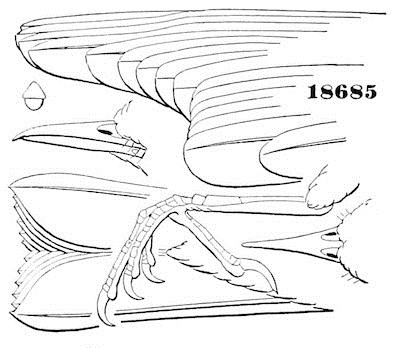
Mniotilta varia, Vieill.
18685
Sp. Char. Bill with the upper mandible considerably decurved, the lower straight. General color of the male black, the feathers broadly edged with white; the head all round black, with a median stripe in the crown and neck above, a superciliary and a maxillary one of white. Middle of belly, two conspicuous bands on the wings, outer edges of tertials and inner of all the wing and tail feathers, and a spot on the inner webs of the outer two tail-feathers, white. Rump and upper tail-coverts black, edged externally with white. Female similar; the under parts white, obsoletely streaked with black on the sides and under tail-coverts. Length, 5 inches; wing, 2.85; tail, 2.25.
Hab. Eastern Province of North America, and north to Fort Simpson. Both coasts of Mexico (as far north as Mazatlan, on west side), and southward to Bogota. Whole of West Indies and Bermuda.
Localities quoted. Bahamas; Bermuda; Cuba; Jamaica; Santa Cruz; West Indies; Cordova, Xalapa, Oaxaca, Mex.; Guatemala; Panama R. R.; Bogota.
Specimens breeding in the Southern States differ in rather longer bill and less amount of black, but are otherwise undistinguishable.
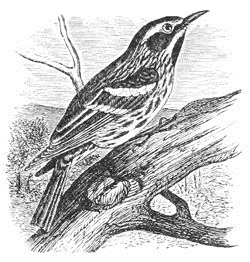
Mniotilta varia.
Habits. The Black and White Creeper, nowhere an abundant species, is met with in various sections of the country. It occurs in all parts of New England and New York, and has been found in the interior as far north as Fort Simpson. It has been met with on the Pacific coast only at Mazatlan, is common in the Bahamas and most of the West India Islands, generally as a migrant. It has also been found in Texas, in the Indian Territory, and in Mexico, and throughout Central America. In the last-named region Mr. Salvin states it to be pretty equally and generally spread over the whole country. It is there migratory, leaving in spring. It was also detected in Colombia, South America, by Mr. C. W. Wyatt. Mr. Newton also met with it as a winter visitant in St. Croix, leaving that island at the end of March. He regards this species as almost a thorough Creeper in habits. In Jamaica a few are resident throughout the year, according to the observations of Mr. March, and though its nests have never been found there, a son of Mr. March saw a pair carrying materials with which to construct one.
Dr. Coues states that this Warbler is a very common summer resident near Washington, but is more abundant there in the spring and in the fall, the greater number going farther north to breed. They arrive in Washington during the first week in April, and are exceedingly numerous until May. He adds that they are generally found in high open woods, and that they “breed in holes in trees.” This is probably an error, or, if ever known to occur, an entirely exceptional case.
Our bird is also a common summer visitant at Calais, arriving there about the 1st of May, and by the 10th becoming rather abundant. Mr. Boardman has frequently found their nests there, and always on the ground, in rocky places and usually under small trees.
It does not appear to have been met with on the Pacific coast north of Mazatlan, nor in any portion of Western North America, beyond the valleys of the Mississippi and the Rio Grande.
In its habits this bird seems to be more of a Creeper than a Warbler. It is an expert and nimble climber, and rarely, if ever, perches on the branch of a tree or shrub. In the manner of the smaller Woodpeckers, the Creepers, Nuthatches, and Titmice, it moves rapidly around the trunks and larger limbs of the trees of the forest in search of small insects and their larvæ. It is graceful and rapid in movement, and is often so intent upon its hunt as to be unmindful of the near presence of man.
It is found chiefly in thickets, but this is probably owing to the fact that there its food is principally to be obtained. It is occasionally seen in more open country, and has been known to breed in the immediate vicinity of a dwelling.
Wilson regarded this bird as a true Creeper, and objected to its being classed as a Warbler. He even denied to it the possession of any song. In this he was quite mistaken. Though never loud, prolonged, or powerful, the song of this Warbler is very sweet and pleasing. It begins to sing from its first appearance in May, and continues to repeat its brief refrain at intervals almost until its departure in August and September. Nuttall speaks of it as being at first a monotonous ditty, and as uttered in a strong but shrill and filing tone. These notes, he adds, as the season advances, become more mellow and warbling, and, though feeble, are pleasing, and are similar to those of the Redstart. But this statement does not do full justice to the varied and agreeable notes with which, in early spring, these birds accompany their lively hunt for food among the tops of the forest trees. They are diversified and sweet, and seem suggestive of a genial and happy nature.




